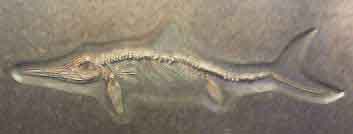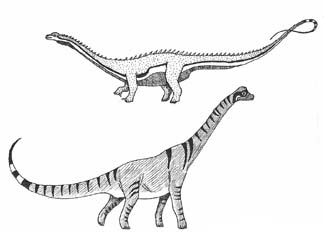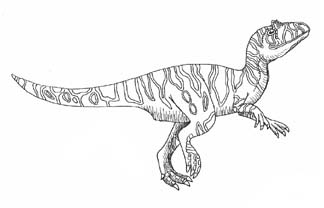Sign up for Lesson Plans, discounts & more!
The Jurassic Period:
The Age of Dinosaurs
The Jurassic Period was the Age of the Dinosaurs. It began after the Triassic Period around 206 million years ago. It lasted until 144 million years ago, more than 60 million years in the middle of the Mesozoic Era.
Pangea Splits
Pangea
continued to split apart during the Jurassic. This caused volcanoes to
erupt along the Tethys Sea floor where the rift between the continents
began.
North American Mountain Building
On the ocean side of
Pangea, the plates continued to collide. One plate was being forced
under another. Folds, uplifts and volcano eruptions occurred along the
moving plates. The mountains that stretch from British Columbia, through
North America and into South America were beginning to form during this time.
Warm Climate Fosters New Species
The
climate was warm and stable. Many types of animals and plants developed.
The numbers of different species increased greatly during the Jurassic
Period.
The Seas of The Jurassic
In the seas, there were more and more invertebrate species. Belemnites and ammonites increased and were the most important of the invertebrates during the Jurassic Period. Gastropods, or sea snails, were a mollusk that grew plentiful in the Jurassic period. Corals began to produce reefs in the warm seas. There were many types of bony fishes, sharks and rays swimming in the tropical seas.
Predators of The Deep
The
seas of the Jurassic Period were filled with predators. The ammonites,
belemnites, and fish were all excellent hunters. This may be the reason
for some species’ numbers growing fewer. There were not as many
brachiopods or crinoids as in the previous periods. These animals, that
stayed fixed on the sea floor, could not complete with the moving
predators for food.
Mega Predators-The Marine Reptiles
The marine reptiles that had gotten their start during the Triassic Period increased in numbers, too. Ichthyosaurs and plesiosaurs were most plentiful during the Jurassic. They shared the sea with early crocodiles.
Abundant Plant Life Feeds The Dinosaurs
As the land pulled
apart, the seas rose. Warm shallow seas again covered parts of Laurasia
(North America and Eurasia). With the warm seas touching the land, the
climate became more humid and tropical. Plants grew thick and tall.
There were so many cycads that the Jurassic is also known as the
Age of Cycads. Cycads are a seed plant with leaves that look like palms.
They have heavy trunks. Cycads still exist in modern times, but they
are not as large or as plentiful as the ones that lived during the
Jurassic Period. All of this plant life fed the many different types of
herbivorous dinosaurs that developed. Of course lots of herbivores means
good eating for the carnivores. So many different types of dinosaurs
lived during this period that it is known as the Age of the Dinosaurs.
Jurassic Park?
There
are many misunderstandings about dinosaurs. Movies and TV have led us
to believe many things that aren’t really true about how and when
dinosaurs lived. For example, the movie Jurassic Park included
Tyrannosaurus Rex and Velociraptors as some of the “star” dinosaurs. In
fact, neither T-Rex nor Velociraptors existed until long after the
Jurassic Period was over.
The Sauropods-Dinosaur Giants
The largest dinosaurs during the Jurassic Period were the sauropods. These dinosaurs stood on four thick legs. They had long necks
and long tails to help give them balance. Some of these sauropods were
gigantic. Brachiosaurus weighed about 55 tons! Diplodocus was the
longest sauropod. It could grow to be 45 feet long!
The Theropods-Two Legged Hunters
The Theropods
walked on two legs and were carnivorous. They were vicious meat-eaters.
Allosaurus was a Jurassic theropod. Allosaurus grew to be 35 feet tall.
It had a thick tail which helped it balance on its hind legs. The front
legs were very short, but each “hand” had long sharp claws. The
allosaurus feet had three long toes with talons like an eagle. This
dinosaur was a fierce predator!
The Ornithopods-Bird Hipped Plant Eaters
All
dinosaurs were not carnivorous. Many ate only plants. These were the
herbivores or herbivorous dinosaurs. The huge sauropods were herbivores.
Stegosaurus was also an herbivorous, plant-eating, dinosaur. It had
plates in two long rows along its back. Although it looks a little like a
sauropod, it belongs to another group, the ornithopods. The ornithopods had a hip structure more like that of modern birds. All ornithopods were plant-eaters.
Bird like Dinosaurs or Dinosaur like Birds?
The first bird-like species developed during the Jurassic. Archaeopteryx
is a well-known example of a link between dinosaurs and
birds. Archaeopteryx had some characteristics of the dinosaurs like a
long tail, and finger claws. It also had some characteristics of modern
birds like feathers.
In recent times many fossils have been found with both dinosaur and bird characteristics. Confuciusornus is one found in China. Some raptor species have been found with clear feather imprints. Most paleontologists today consider birds to be closely related to the dinosaurs. The Archaeopteryx may not have been the first dinosaur to have feathers. But it did cause scientists to rethink the definition of birds.
Mammals
Mammals
continued through the Jurassic Period. They remained small. Many
different species developed, but the mammals were still not playing a
large part in the day-to-day life of the Jurassic. That was all about
the dinosaurs!
Return to Geologic Time Line
Before The Jurassic Period was the Triassic Period
The next period is The Cretaceous Period
Check out some of the Educational Materials for sale on our sister site fossilicious.com.

interested in more? If so, you may want to check out our other sites:
fossilicious.com - Our online fossil and mineral rock shop.
rocksandminerals4u.com - An educational site about rocks, minerals, and geology.
Geologic Time Geologic Time Line
Cenozoic Era
Quaternary
Neogene
Paleogene
Mesozoic Era
Cretaceous
Jurassic
Triassic
Paleozoic Era
Permian
Carboniferous
Devonian
Silurian
Ordovician
Cambrian
Archean Time
Hadean Time
Teachers Resources
Activities for Education and Fun
Earth Science Lesson Plans
Activities For Kids
Fossil Lesson Plans
Fossil Activities
Education Articles
Coloring Pages
Dinosaur Coloring Pages
Montessori Materials
Geology Club
Fossil Hunting
 |
 |
 |








